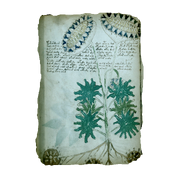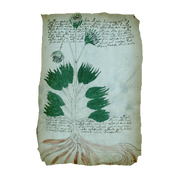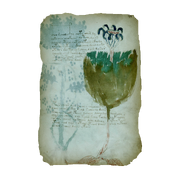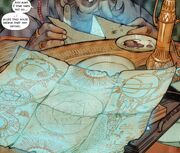
|
Patience, brothers. Soon we will reveal the secrets of Assassin's Creed: The Ming Storm. This article has been identified as being out of date. Please update the article to reflect recent releases and then remove this template once done. |
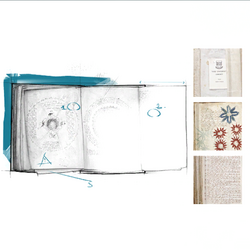
Voynich manuscript
The Voynich manuscript is an illustrated codex hand-written in the Isu language.[1]
Owners[]
- Complete
- Order of the Ancients (860s)[2]
- Zahra (860s)[2]
- Hunayn ibn Ishaq (860s)[2]
- Rudolf II, Holy Roman Emperor (? – ?)[3]
- Pages
- Vasco da Gama (likely; ? – ?)[4]
- Peter Beckford (? – ?)[3]
- Edward Kenway (1715 – 1722)[3]
- François Mackandal (? - 21 November 1751)[1]
- Lawrence Washington (21 November 1751 – July 1752)[1]
- James Wardrop (July 1752 – July 1754)[1]
- Colonial Assassins (July 1754 – 1756)[1]
- Shay Cormac (1756)[1]
- George Monro (1756 – August 1757)[1]
- Shay Cormac (August 1757)[1]
- George Monro (November 1757)[1]
- Colonial Assassins (November 1757 – October 1759)[1]
- Liam O'Brien (October 1759 – March 1760)[1]
- Shay Cormac (March 1760 – ?)[1]
- Arbaaz Mir (June 1839)[5]
- Hamid (June 1839 – ?)[5]
- Templars (1868 – 1872)[6]
- Horace Greeley (1872)[6]
- Alice (1872)[6]
History[]
Early history[]
Commonly, though erroneously, believed to have been written around 1405, the artifact was created long before.[3] By the 860s, it was kept in the House of Wisdom in Baghdad. The Order of the Ancients led by Fazil Fahim al-Kemsa sought to create a device with artifacts found at a dig site southwest of the city, and wished to use knowledge from the manuscript to do so.[7]

Basim and Hunayn ibn Ishaq trying to read the manuscript
Fazil tasked his fellow Order member Zahra with stealing the manuscript, which she did after murdering the library's caretaker. Discovering the book to be written in an ancient language, Zahra kidnapped the translator Hunayn ibn Ishaq, who was one of the finest translators in the Caliphate, and forced him to attempt a translation at the Scriptorium. However, even with his skills, he was not able to read or decode the manuscript.[7]
Hunayn was later rescued by the Hidden One Basim Ibn Ishaq and revealed the manuscript's content which no one had seen before. After Hunayn left to return home, Basim made the decision to leave the book behind before leaving as well.[7]
By the late 16th century, Emperor Rudolf II of the Holy Roman Empire was the last known owner of the complete manuscript, although four of the manuscript's pages eventually wound up in the hands of Governor Peter Beckford of Jamaica by the early 18th century. After they were taken from the Beckford estate, the pages were scattered across the Caribbean, until they were eventually collected by the pirate-turned-Assassin Edward Kenway between 1715 and 1722.[3]
American Colonies[]
- "The Manuscript the Assassins sought has been in my possession for some time. I reclaimed it when my men found you marooned. The Grand Master himself charged me to discover its meaning, a task I regret I have failed to complete. I leave it in your charge, Master Cormac. There is no one else I trust more."
- ―George Monro entrusting the manuscript to Shay Cormac. 1757.[src]-[m]
In the following decades, the Assassins and Templars alike learned of the connection between the manuscript and the mysterious Precursor box, one of the only devices that could translate its incomprehensible text. By 1751, both the box and several pages of the manuscript were in possession of François Mackandal, the Mentor of the Saint-Domingue Assassins. Using the two artifacts in tandem, Mackandal learned the location of an Isu temple near Port-au-Prince and sent one of his Assassins, Vendredi, to explore it and retrieve its Piece of Eden.[8]
When Vendredi removed the Piece at the heart of the temple, he triggered a devastating earthquake and became trapped under rubble from the temple's destruction. The Templar Lawrence Washington, who had followed Vendredi, killed the trapped Assassin after interrogating him to learn the location of Mackandal's camp. He subsequently infiltrated it and stole the Precursor box and the manuscript before fleeing back to the Thirteen Colonies.[8]

Shay taking the manuscript from a dying James Wardrop
In July 1752, Washington held a meeting with his fellow Templars at his Mount Vernon estate in Virginia, where he entrusted the box and the manuscript to Samuel Smith and James Wardrop, respectively. The Colonial Assassin Shay Cormac killed Washington shortly after the meeting[9] and, two years later, also assassinated Smith and Wardrop, reclaiming the two artifacts for the Brotherhood.[10][11]
In July 1754, the inventor Benjamin Franklin became the second known person to properly use the Precursor box and the manuscript in tandem, after Shay and his fellow Assassin Hope Jensen requested his help to unravel the box's secrets. Electrifying the box with lighting, Franklin was able to generate a map of the world indicating the locations of several Seismic Temples, including one in Haiti and another in Lisbon, Portugal.[12]
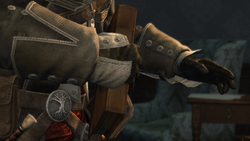
Shay stealing the manuscript from the Assassins
Following this, the manuscript remained in the Colonial Assassins' possession until 1756, when Shay returned to the Davenport Homestead after his mission to retrieve the Piece of Eden from the Lisbon Temple. As his tampering with the temple had caused an earthquake similar to the one in Port-au-Prince, Shay wished to prevent the Assassins from finding any more temples and endangering more innocent lives. To achieve this, he resolved to steal the manuscript from the Homestead, but during his theft he was caught by the Assassins and chased to a cliff, where he was left for dead after being shot by Louis-Joseph Gaultier.[13]
Shay was later rescued by the Templar George Monro, who left him in the care of Barry and Cassidy Finnegan and took the manuscript for himself.[14] Monro was subsequently tasked by the Colonial Templars' Grand Master, Haytham Kenway, to uncover the book's secrets, but was unable to do so. In August 1757, after Shay had proven his loyalty to the Templars, Monro gave him back the manuscript and told him about his mission from Haytham, asking for his help in deciphering the book.[15]
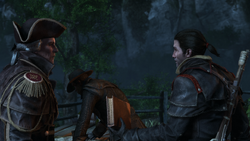
Shay giving the manuscript to Monro
Later that year, during an attack on Albany, Shay attempted to save Monro from the Assassin Kesegowaase and his native allies. Once he accomplished his mission, Shay gave Monro the manuscript, claiming that it was safer in his hands, and sent him to the Morrigan, while he stayed at Fort Frederick and battled Kesegowaase. When Shay managed to kill him, Kesegowaase revealed with his last words that the Assassin Liam O'Brien had already killed Monro and stolen the manuscript.[16]
In October 1759, the Assassins were making preparations for an expedition to find another Seismic Temple, after Hope Jensen had managed to replicate Benjamin Franklin's experiment with the Precursor box and used the manuscript to determine the temple's location.[17] Following this, Liam took the book and kept it with him until his death in March 1760, after which Shay claimed back the manuscript for the Templars.[18]
Other pages[]
- "The transcription reads: 'He who owns this diamond will own the world, but will also know all its misfortunes. Only God, or a woman can wear it with impunity.'"
- ―Hamid telling Arbaaz Mir of the manuscript's warning about the Koh-i-Noor, 1839.[src]
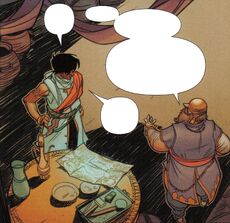
Arbaaz and Hamid standing over a manuscript map
In June 1839, Hamid, the Mentor of the Indian Assassins, tasked Arbaaz Mir with the recovery of a map from the Voynich manuscript detailing information on the Koh-i-Noor, during their quest to protect the artifact from falling into the British Templars' hands.[5]
After Ulysses S. Grant's election as President of the United States in 1868, Grant's inner circle was infiltrated by members of the Templar Order, who subsequently corrupted his administration. They helped him master the powers of the prong the Assassins had given him during the war, by giving him access to a Precursor box and pages of the Voynich manuscript.[6]
In 1872, after Grant's political rival, Horace Greeley, stole the pages from Grant's office, the Templars poisoned him and later sent one of their agents, Alice, to finish the dying man and recover the artifact. While Alice failed to kill Greeley due to the intervention of a Pinkerton agent, Tommy Greyling, she nevertheless escaped with the pages.[6]
That same year, new pages were discovered and brought to the British Museum in London, and Alice was once again sent to steal it by her superiors. She succeeded, despite being pursued by Greyling, who had allied himself with the Assassins Evie Frye and Henry Green. However, after being cornered on the deck of the ship bringing her back to America, she threw the pages into the Atlantic Ocean before committing suicide.[6]
Modern times[]
In 2013, Abstergo Industries warned memory research analysts at Abstergo Entertainment, who were assigned to relive the memories of European subjects during the 15th and 16th centuries, to look out for the Voynich manuscript during their Animus sessions, especially for its supposed connection to the English philosopher Roger Bacon.[19]
In 2020, the Assassin Antony Henry mentioned the manuscript in his notes to Layla Hassan detailing his efforts translating some Isu script found in Canterbury, noting that it used a cursive form of the alphabet used in the book. He added that he had tried to translate some of the manuscript's pages, but was unsuccessful and theorized that the text required a Precursor box to decode it.[20]
Trivia[]
- The manuscript is named after book dealer Wilfrid Voynich, who purchased it in 1912.
- It is theorized that the Voynich manuscript may have been sold to Rudolf II by John Dee. Another theory suggests that the manuscript was written by Edward Kelley, who could speak with members of the First Civilization through his Crystal Ball.
- The map Arbaaz acquired features the Voynich manuscript pages Folio 70r and 75r, as well as drawings of the Koh-i-Noor, two Apples of Eden, a Memory Seal and symbols found on Marcus Junius Brutus' drawing of the Colosseum Vault.
Gallery[]
Appearances[]
- Assassin's Creed IV: Black Flag (first appearance)
- Assassin's Creed: Brahman
- Assassin's Creed: Rogue
- Assassin's Creed: Last Descendants – Locus
- Assassin's Creed: Valhalla (mentioned only)
- Assassin's Creed: Mirage (unnamed)
Non-canonical appearances[]
References[]
- ↑ 1.00 1.01 1.02 1.03 1.04 1.05 1.06 1.07 1.08 1.09 1.10 1.11 Assassin's Creed: Rogue
- ↑ 2.0 2.1 2.2 Assassin's Creed: Mirage
- ↑ 3.0 3.1 3.2 3.3 3.4 Assassin's Creed IV: Black Flag
- ↑ Assassin's Creed IV: Black Flag – Database: "De Gama Diary Extract"
- ↑ 5.0 5.1 5.2 Assassin's Creed: Brahman
- ↑ 6.0 6.1 6.2 6.3 6.4 6.5 Assassin's Creed: Last Descendants – Locus
- ↑ 7.0 7.1 7.2 Assassin's Creed: Mirage – Follow the Fiery Trail
- ↑ 8.0 8.1 Assassin's Creed: Rogue – War Letters
- ↑ Assassin's Creed: Rogue – By Invitation Only
- ↑ Assassin's Creed: Rogue – One Little Victory
- ↑ Assassin's Creed: Rogue – We the People
- ↑ Assassin's Creed: Rogue – Fiat Lux
- ↑ Assassin's Creed: Rogue – Freewill
- ↑ Assassin's Creed: Rogue – The Color of Right
- ↑ Assassin's Creed: Rogue – Honour and Loyalty
- ↑ Assassin's Creed: Rogue – Scars
- ↑ Assassin's Creed: Rogue – Caress of Steel
- ↑ Assassin's Creed: Rogue – Non Nobis Domine
- ↑ Assassin's Creed IV: Black Flag – Noob's personal files
- ↑ Assassin's Creed: Valhalla – Layla Hassan's personal files
| ||||||||||||||||||||||||||||||||||
| |||||||||||||||||||||||||||||||
| ||||||||||||||||||||||||||||

